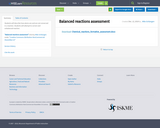
Students will describe how atoms are and are not conserved in a reaction. Students will attempt to correct and unbalanced reaction.
- Subject:
- Chemistry
- Physical Science
- Material Type:
- Formative Assessment
- Date Added:
- 12/12/2018

Students will describe how atoms are and are not conserved in a reaction. Students will attempt to correct and unbalanced reaction.

Students learn about the similarities between the human brain and its engineering counterpart, the computer. Since students work with computers routinely, this comparison strengthens their understanding of both how the brain works and how it parallels that of a computer. Students are also introduced to the "stimulus-sensor-coordinator-effector-response" framework for understanding human and robot actions.

This is a demonstration of carbon dioxide's solubility into an aqueous solution. A candle and beaker of pink phenolphthalein solution are placed inside a jar. The candle is lit and the jar is capped. The flame expectedly goes out as the oxygen is depleted. After the flame is extinguished, the pink solution slowly fades to colorless.

This course introduces the basic driving forces for electric current, fluid flow, and mass transport, plus their application to a variety of biological systems. Basic mathematical and engineering tools will be introduced, in the context of biology and physiology. Various electrokinetic phenomena are also considered as an example of coupled nature of chemical-electro-mechanical driving forces. Applications include transport in biological tissues and across membranes, manipulation of cells and biomolecules, and microfluidics.
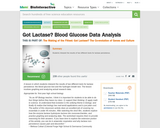
A lesson in which students interpret the results of two different tests for lactase persistence: the blood glucose test and the hydrogen breath test. The lesson involves graphing and analyzing actual research data.
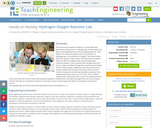
This lab exercise exposes students to a potentially new alternative energy source hydrogen gas. Student teams are given a hydrogen generator and an oxygen generator. They balance the chemical equation for the combustion of hydrogen gas in the presence of oxygen. Then they analyze what the equation really means. Two hypotheses are given, based on what one might predict upon analyzing the chemical equation. Once students have thought about the process, they are walked through the experiment and shown how to collect the gas in different ratios. By trial and error, students determine the ideal combustion ratio. For both volume of explosion and kick generated by explosion, they qualitatively record results on a 0-4 scale. Then, students evaluate their collected results to see if the hypotheses were correct and how their results match the theoretical equation. Students learn that while hydrogen will most commonly be used for fuel cells (no combustion situation), it has been used in rocket engines (for which a tremendous combustion occurs).
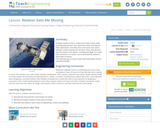
In this lesson, students will explore motion, rockets and rocket motion while assisting Spacewoman Tess, Spaceman Rohan and Maya in their explorations. They will first learn some basic facts about vehicles, rockets and why we use them. Then, the students will discover that the motion of all objects including the flight of a rocket and movement of a canoe is governed by Newton's three laws of motion.
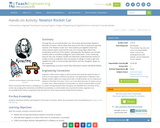
The purpose of this activity is to demonstrate Newton's third law of motion which states that every action has an equal and opposite reaction through a small wooden car. The Newton cars show how action/reaction works and how the mass of a moving object affects the acceleration and force of the system. Subsequently, the Newton cars provide students with an excellent analogy for how rockets actually work.

Intermediate organic chemistry. Synthesis, structure determination, mechanism, and the relationships between structure and reactivity emphasized. Special topics in organic chemistry included to illustrate the role of organic chemistry in biological systems and in the chemical industry.
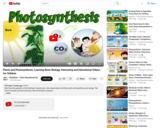
Help Sam the gardener in the Sunflower Greenhouse. Learn about plants and their parts, photosynthesis and energy. This lesson includes practical exercises. Good for grade 3.
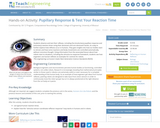
Students observe and test their reflexes, including the (involuntary) pupillary response and (voluntary) reaction times using their dominant and non-dominant hands, as a way to further explore how reflexes occur in humans. They gain insights into how our bodies react to stimuli, and how some reactions and body movements are controlled automatically, without conscious thought. Using information from the associated lesson about how robots react to situations, including the stimulus-to-response framework, students see how engineers use human reflexes as examples for controls for robots.
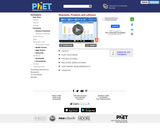
Create your own sandwich and then see how many sandwiches you can make with different amounts of ingredients. Do the same with chemical reactions. See how many products you can make with different amounts of reactants. Play a game to test your understanding of reactants, products and leftovers. Can you get a perfect score on each level?
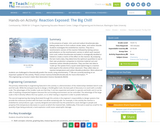
Students investigate the endothermic reaction involving citric acid, sodium bicarbonate and water to produce carbon dioxide, water and sodium citrate. In the presence of water [H2O], citric acid [C6H8O7] and sodium bicarbonate [NaHCO3] (also known as baking soda) react to form sodium citrate [Na3C6H5O7], water [H2O], and carbon dioxide [CO2]. Students test a stoichiometric version of the reaction followed by testing various perturbations on the stoichiometric version in which each reactant (citric acid, sodium bicarbonate, and water) is strategically doubled or halved to create a matrix of the effect on the reaction. By analyzing the test matrix data, they determine the optimum quantities to use in their own production companies to minimize material cost and maximize CO2 production. They use their test data to "scale-up" the system from a quart-sized ziplock bag to a reaction tank equal to the volume of their classroom. They collect data on reaction temperature and CO2 production.
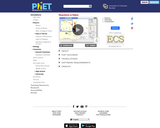
Explore what makes a reaction happen by colliding atoms and molecules. Design experiments with different reactions, concentrations, and temperatures. When are reactions reversible? What affects the rate of a reaction?
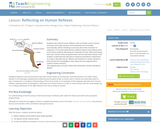
Students learn about human reflexes, how our bodies react to stimuli and how some body reactions and movements are controlled automatically, without thinking consciously about the movement or responses. In the associated activity, students explore how reflexes work in the human body by observing an involuntary human reflex and testing their own reaction times using dominant and non-dominant hands. Once students understand the stimulus-to-response framework components as a way to describe human reflexes and reactions in certain situations, they connect this knowledge to how robots can be programmed to conduct similar reactions.
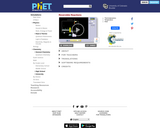
Watch a reaction proceed over time. How does total energy affect a reaction rate? Vary temperature, barrier height, and potential energies. Record concentrations and time in order to extract rate coefficients. Do temperature dependent studies to extract Arrhenius parameters. This simulation is best used with teacher guidance because it presents an analogy of chemical reactions.
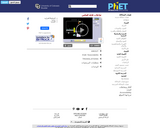
Watch a reaction proceed over time. How does total energy affect a reaction rate? Vary temperature, barrier height, and potential energies. Record concentrations and time in order to extract rate coefficients. Do temperature dependent studies to extract Arrhenius parameters. This simulation is best used with teacher guidance because it presents an analogy of chemical reactions.
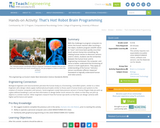
With the challenge to program computers to mimic the human reaction after touching a hot object, students program LEGO® robots to "react" and move back quickly once their touch sensors bump into something. By relating human senses to electronic sensors used in robots, students see the similarities between the human brain and its engineering counterpart, the computer, and come to better understand the functioning of sensors in both applications. They apply an understanding of the human "stimulus-sensor-coordinator-effector-response" framework to logically understand human and robot actions.